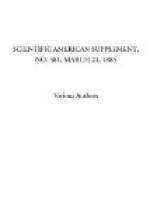[Illustration: 12m: FIG. 13.—Syringodendron pes-caprae; from Saarbruck; radial vertical section, X200.]
[Illustration: 12n: FIG. 14.—Suberose cells restored.]
In anatomical structure, the barks of the Syringodendrons are, then, analogous to those of the Sigillariae. If, now, we compare the dimensions of the tissues of these barks with the same silicified tissues of the barks of Sigillariae, we shall find that there was likewise a diminution in the dimensions, but yet a less pronounced one than in the woods that we have previously spoken of. The corky nature of this region of the bark was likely richer in carbonizable elements than the wood properly so called, and had, in consequence, to undergo much less shrinkage.—Dr. B. Renault (of Paris Museum) in Le Genie Civil.
[Illustration: 12o: FIG. 15.—Syringodendron pes-caprae; tangential vertical section in the corky part of the bark, X200.]
DESCRIPTION OF THE FIGURES.—Fig. 1, Lancashire cannel coal; longitudinal section, X200. Fig. 2, Lancashire cannel coal; transverse section, X200. Fig. 3. Commentry cannel coal, X200. Fig. 4, Pennsylvania anthracite, X200. Fig. 5, Boghead from New South Wales, X500. Fig. 6, Arthropitus gallica, St. Etienne; transverse section, X200. Fig. 7, same; tangential longitudinal section. Fig. 8, same; transverse section through the carbonized part. Fig. 9. Calamodendron, Commentry; prosenchymatous portion of the wood carbonized, X200. Fig. 10, same; fragment of the vascular portion of the wood carbonized. Fig. 11, same, from Autun; prosenchymatous portion of the wood silicified, X200. Fig. 12, same, Autun; vascular portion of the wood silicified. Fig. 13, Syringodendron pes-caprae; from Saarbruck; radial vertical section, X200. Fig. 14, Suberose cells restored. Fig. 15. Syringodendron pes-caprae; tangential vertical section in the corky part of the bark, X200.
* * * * *
ICE BOAT RACES ON THE MUEGGELSEE, NEAR BERLIN.
The interest in sports of different kinds is increasing considerably in the capital of the German Empire. Oarsmen and sailors show their ability in grand regattas; roller-skating rinks are very, popular; numerous bicycle clubs arrange grand tournaments; and training, starting, trotting, swimming, turning, fencing, walking, and running are practiced everywhere. As this winter has been quite severe in Germany, first class courses have been made for ice boats. Ice boat, races are well known in the United States, but are quite novel in Germany; at least, in the neighborhood of Berlin, as they have been known only on the coast of the Baltic Sea.




